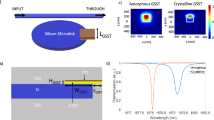Abstract
Dynamic reconfigurable devices present new computational paradigms because programmable devices’ activity and performance can be improved dramatically by increasing its reconfiguration frequency. Therefore, this paper presents designs of optically differential reconfigurable gate array (ODRGA) VLSIs using 0.18 μm and 0.35 μm CMOS process technologies. Although they are a type of programmable gate array, they can be reconfigured optically in nanoseconds. This paper also discusses future scaling prospects of ODRGA-VLSIs.











Similar content being viewed by others
References
Altera Corporation, Altera devices, http://www.altera.com/products/devices/dev-index.jsp.
Xilinx Inc., Silicon devices, http://www.xilinx.com/products/silicon_solutions/index.htm.
Lattice Semiconductor Corporation, Key solutions/products, http://www.latticesemi.com.
IPFlex Inc., Products, http://www.ipflex.com/en.
Nakano, H., Shindo, T., Kazami, T., & Motomura, M. (2003) Development of dynamically reconfigurable processor LSI. NEC Technical Journal (Japan), 56(4), 99–102.
Dehon, A. (1996). Dynamically programmable gate arrays: A step toward increased computational density (pp. 47–54). Fourth Canadian Workshop on Field Programmable Devices.
Scalera, S. M., & Vazquez, J. R. (1998). The design and implementation of a context switching FPGA (pp. 78–85). IEEE Symposium on FPGAs for Custom Computing Machines.
Trimberger, S. et al. (1997). A time-multiplexed FPGA (pp. 22–28). FCCM.
Jones, D., & Lewis, D. M.(1995). A time-multiplexed FPGA architecture for logic emulation. (pp. 495–498) Custom Integrated Circuits Conference.
Mumbru, J., Panotopoulos, G., Psaltis, D., An, X., Mok, F., Ay, S., Barna, S., & Fossum, E. (2000). Optically programmable gate array. SPIE of Optics in Computing, 4089, 763–771.
Mumbru, J., Zhou, G., An, X., Liu, W., Panotopoulos, G., Mok, F., & Psaltis, D. (1999). Optical memory for computing and information processing. SPIE on Algorithms, Devices, and Systems for Optical Information Processing III, 3804, 14–24, 1999.
Mumbru, J., Zhou, G., Ay, S., An, X., Panotopoulos, G., Mok, F. & Psaltis, D. (1999). Optically Reconfigurable Processors. SPIE Critical Review 1999 Euro-American Workshop on Optoelectronic Information Processing, 74, 265–288.
Watanabe, M., & Kobayashi, F. (2002). An optically differential reconfigurable gate array and its power consumption estimation (pp. 197–202). IEEE International Conference on Field-Programmable Technology.
Miyano, M., Watanabe, M., & Kobayashi, F. (2005). Rapid reconfiguration of an optically differential reconfigurable gate array with pulse lasers (pp. 287–288). IEEE International Conference on Field-Programmable Technology.
Watanabe, M., & Kobayashi, F. (2004). An optically differential reconfigurable gate array using a 0.18 um CMOS process (pp. 281–284). IEEE International SOC Conference.
Seto, D., & Watanabe, M. (2008). A dynamic optically reconfigurable gate array—perfect emulation. IEEE Journal of Quantum Electronics, 44(5), 493–500.
Seto, D., & Watanabe, M. (2008). A dynamic optically reconfigurable gate array with a silver-halide holographic memory (pp. 511–514). IEEE Computer Society Annual Symposium on VLSI.
Miyazaki, R., Watanabe, M., & Kobayashi, F. (2007). A multi-context holographic memory recording system for optically reconfigurable gate arrays. IEEE International Parallel & Distributed Processing Symposium, CD-ROM.
Betz, V., & Rose, C. J. (1997). VPR: A new packing placement and routing tool for FPGA research. Seventh International Workshop on Field-Programmable Logic and Application.
Acknowledgments
This research is supported by the Ministry of Internal Affairs and Communications of Japan under the Strategic Information and Communications R&D Promotion Programme (SCOPE). The VLSI chip in this study was fabricated in the chip fabrication program of VLSI Design and Education Center (VDEC), the University of Tokyo in collaboration with Rohm Co. Ltd. and Toppan Printing Co. Ltd.
Author information
Authors and Affiliations
Corresponding author
Rights and permissions
About this article
Cite this article
Watanabe, M., Shiki, T. & Kobayashi, F. Scaling prospect of optically differential reconfigurable gate array VLSIs. Analog Integr Circ Sig Process 60, 137–143 (2009). https://doi.org/10.1007/s10470-008-9210-9
Received:
Revised:
Accepted:
Published:
Issue Date:
DOI: https://doi.org/10.1007/s10470-008-9210-9




